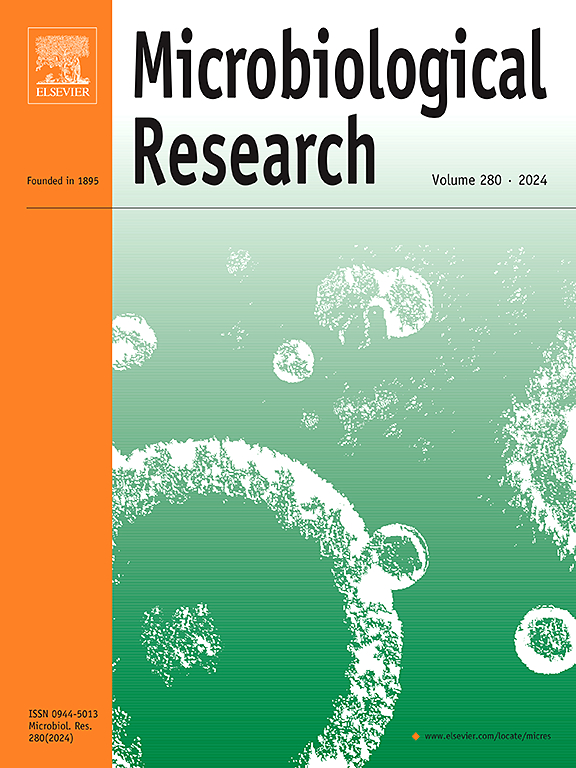鸡源在将多药耐药广谱产内酰胺酶肠杆菌科引入有机肉鸡养殖场中的重要性
IF 6.9
1区 生物学
Q1 MICROBIOLOGY
引用次数: 0
摘要
多药耐药(MDR)和产生广谱β -内酰胺酶(ESBL)的肠杆菌科细菌出现在有机肉鸡生产中,尽管抗生素的使用有限。它们的起源还不完全清楚。本研究对德国某有机肉鸡养殖场育肥期耐药大肠杆菌和肺炎克雷伯菌的遗传背景和传播动态进行了研究。从雏鸡日龄到屠宰年龄,连续对4个鸡群进行5次采样。用肉汤微量稀释法对每个样品检测每个细菌的三个分离株。在一个孵卵场提供的1-3群中,37.8% %(17/45)的非选择性培养基中大肠杆菌从日龄鸡开始呈现MDR表型,但未检测到esbl产生者。相反,73.3%(11/15)的样本从选择性培养基中分离出MDR和产生esbl的肺炎克雷伯菌。全基因组测序结果显示,MDR和esbl产肺炎克雷伯菌克隆携带一个结合的IncFII/IncFIB耐药质粒,属于ST307,这是一个新兴的人类医学高风险克隆。MDR大肠杆菌具有遗传多样性,克隆型MDR ST162和ST57大肠杆菌群明显不同。在另一个孵化场提供的第4群中,未检测到耐多药或产生esbl的大肠杆菌和肺炎克雷伯菌。大肠杆菌66.7 %、肺炎克雷伯菌100% %完全易感。这些结果表明,外部来源,特别是鸡源,对将耐药细菌引入有机肉鸡养殖场的影响。需要进一步研究MDR和产esbl肠杆菌科在有机种鸡群和孵卵场的流行情况和遗传背景,以确定潜在的传播事件并改进预防策略。本文章由计算机程序翻译,如有差异,请以英文原文为准。
Importance of chick origin in introducing multidrug-resistant and extended-spectrum beta-lactamase-producing Enterobacteriaceae into an organic broiler farm
Multidrug-resistant (MDR) and extended-spectrum beta-lactamase (ESBL)-producing Enterobacteriaceae occur in organic broiler production despite limited antimicrobial use. Their origin is not fully understood. This study characterized the genetic background and transmission dynamics of antimicrobial-resistant Escherichia coli and Klebsiella pneumoniae from one German organic broiler farm throughout the fattening period. Four consecutive flocks were sampled five times each, from day-old chicks until slaughter age. Three isolates per bacterium were tested per sample using broth microdilution. In flocks 1–3 supplied by one hatchery, 37.8 % (17/45) of E. coli from non-selective medium showed MDR phenotypes from day-old chicks onwards, but no ESBL-producers were detected. Instead, MDR and ESBL-producing K. pneumoniae were isolated from selective medium in 73.3 % (11/15) of samples. Whole genome sequencing revealed clonal MDR and ESBL-producing K. pneumoniae harboring a conjugative IncFII/IncFIB resistance plasmid and belonging to ST307, an emerging high-risk clone in human medicine. MDR E. coli were genetically diverse, with distinct clusters of clonal MDR ST162 and ST57 E. coli. In flock 4, supplied by a different hatchery, no MDR or ESBL-producing E. coli and K. pneumoniae were detected. 66.7 % of E. coli and 100 % of K. pneumoniae were fully susceptible. These results demonstrate the impact of external sources, particularly chick origin, on introducing of resistant bacteria into organic broiler farms. Further research is needed to assess the prevalence and the genetic background of MDR and ESBL-producing Enterobacteriaceae in organic breeder flocks and hatcheries to identify potential transmission events and improve prevention strategies.
求助全文
通过发布文献求助,成功后即可免费获取论文全文。
去求助
来源期刊

Microbiological research
生物-微生物学
CiteScore
10.90
自引率
6.00%
发文量
249
审稿时长
29 days
期刊介绍:
Microbiological Research is devoted to publishing reports on prokaryotic and eukaryotic microorganisms such as yeasts, fungi, bacteria, archaea, and protozoa. Research on interactions between pathogenic microorganisms and their environment or hosts are also covered.
 求助内容:
求助内容: 应助结果提醒方式:
应助结果提醒方式:


